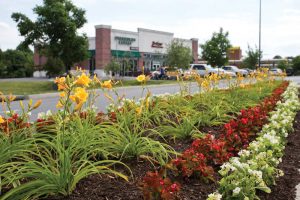— By Eric Brownlee —
Is your landscape management program doing all it can to highlight your brand?
How do you see the landscapes on your properties? Do you consider landscaping as a brand asset, or is it simply something you must maintain to avoid violation notices or adhere to landlord requirements?

Eric Brownlee, Powerhouse
Often a facility’s landscape is overlooked, expectations are not aligned, and the overall asset is not providing all the possible benefits.
One key benefit not to be overlooked is curb appeal. When dining out, you may not consciously make a decision on where to eat based on how welcoming and well-kept the property is. But, in most cases, how you view the property actually does influence your perception of that business. For most people, it is more of a subconscious influence — but not for this landscape nerd!
Consider the following situation: You pull up in your car to an intersection looking to fuel up and perhaps stop for a late dinner after a long drive. To your right you quickly notice that the fuel is a few cents less than the establishment across the street. You then notice that your lesser expensive option has flickering lights, signs that are mostly blocked by overgrown trees and grass that hasn’t been cut in weeks. You then notice that the business across the street is both well lit, neatly maintained and presents a welcoming feel. You decide to cross the street, pay a few cents more, and have an overall better experience. After filling your tank, you are faced with a similar restaurant comparison. Both restaurants are similar in food quality and overall menu, but like the gas station, one presents itself differently: with a well-manicured lawn, pruned trees and colorful, well cared for flowers. Before you even step foot on the property you observe the differences. Which would you choose?
Developing a successful landscape management program for your portfolio must first start with understanding what your landscape means to your brand. Are image and experience important? Then you should clearly lay out what requirements the landscape maintenance should meet in order to achieve those goals. Defining a realistic and clear scope of work is a great way to establish the baseline.
Scope Topics to Consider:
- Turf maintenance frequency or outcome-based management
- Weed and pest tolerances
- Shrub pruning expectations
- Tree pruning standards for clearances, sight lines, security, etc.
- Mulch application
- Irrigation system management
- Inspection / reporting expectations
- Communication protocols
 Once the scope is established, you and the vendor team should discuss both field quality expectations and, more importantly, communication expectations. Who will be the point of contact? How will work orders be invoiced and communicated? Communication is a key success factor in any program, especially one that has a direct impact on your brand and can quickly be impacted by variables that are often unpredictable , like inconsistent weather patterns, significant storms, pests and invasive species population.
Once the scope is established, you and the vendor team should discuss both field quality expectations and, more importantly, communication expectations. Who will be the point of contact? How will work orders be invoiced and communicated? Communication is a key success factor in any program, especially one that has a direct impact on your brand and can quickly be impacted by variables that are often unpredictable , like inconsistent weather patterns, significant storms, pests and invasive species population.
Partnering with the right company is the final step that leads to success for your program. Companies that offer teams who understand the value of your asset (your landscape) and offer solutions that can mitigate long term expense enhance the appearance and brand, and will ultimately help you save money long term. Every program, no matter how long it has been in place, or how recently it has been updated, is open for improvement. Consider adding some of these cost savings and investment enhancement options to your next program:
- Integrate a Pest Management Program to address unwanted pests and disease in the landscape to prevent plant decline and loss.
- Implement irrigation audits to assess overall water usage, technology upgrades, zone reduction for mature plantings, etc.
- Address security, clearance and safety pruning of mature trees throughout the property. Consider having a team come in to assess every property to get a baseline cost of what mature tree pruning is needed across your portfolio.
- Consider landscape conversions in southern and dry climates where water restrictions put your current landscape at a disadvantage.
- Conduct mulch depth assessments to identify where mulch depths have become excessive. Excessive mulch depth is a leading cause of early plant/tree loss. For trees, deep mulch on the trunk of the tree causes girdling roots, choking the tree of water and nutrients. If caught early, this can be remedied and at much lower cost than a tree replacement.
Whether you are developing a new program or considering changing a current one, we recommend you reach out to your trusted providers, as well as established organizations like The National Association of Landscape Professionals and the International Society of Arboriculture for thoughts on implementing ideas like the ones discussed above. The dedicated team of professionals in our exterior services division would be an excellent place to start.
Landscape maintenance is more than a to-do list, it’s a brand asset. When this asset is utilized correctly, it can enhance your bottom line instead of being a line item that takes away from your value and checkbook. Landscape maintenance is an investment, not a nuisance. Make this asset work for you by finding the right team who can unlock the value of your landscape assets for your company and your facilities.
— Eric Brownlee is senior director of operations – exterior services for Powerhouse, a leading provider of nationwide construction services, FM (interior and exterior) and rollouts. Visit www.powerhousenow.com.
